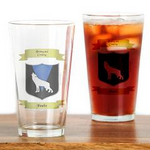Who can see your post?
Your post will show up in News Feed, on your profile and in search results.8,826 Global Carron Family Members
| Days | Hours | Minutes | Seconds |
Sunday 16th March
2pm (New York), 7pm (Ire)
| Days | Hours | Minutes | Seconds |
Sunday 16th March
2pm (New York), 7pm (Ire)
Our in-person family gatherings
Our TEDx talk about family gatherings
Carron Family History
CAREW.png)
(Ó Corráin)
[Carey]
The Norman-Welsh Carews are of the same stock as the FitzGeralds: viz. from the union of Gerald FitzWalter, the Norman Constable of Pembroke (circa 1100) and Nest, Princess of Deheubarth, the 'Helen of Wales'. The family home was at Carew, Pembokeshire, (the castle existing today was built in the 13th century), originally a holding of Nesta's royal father, Rhys Ap Tewdwr. The usual derivation offered is that the root word is 'caer', Middle Welsh for 'fort'; the second element being possibly 'rhiw' - 'slope', or 'yw' - 'yew' (tree). However, there is a River Carew that runs by the castle, and river names are normally regarded as being more ancient than habitation names.
Not all modern Carews are of Carew, Pembrokeshire stock, but bear the name as an Anglicised form, together with Carey, of the Irish patronymic Ó Corráin/Ó Carráin.
Secondly, some bearers of Carew in Wales and England may have the name in the variant form of 'Carey' or 'Cary', which is close to the old local pronunciation of the place Carew; with the proviso that Carey in Britain is more often than not from one of the many Gaelic-Irish surnames Anglicised 'Carey', or from the less numerous Somerset surname 'Cary'.
Gerald FitzWalter's son Maurice FitzGerald and grandson Raymond de Carreu, 'le Gros', took part, alongside Richard de Clare or 'Strongbow', in the invasion of Ireland in 1171. The 'invasion' was almost a family affair, with many of the Cambro-Norman protagonists related through the matriarchal and 'polygamous' Nest: among the cousins of the Geraldines were Robert FitzStephen, Robert de Barry et. al.
In Ireland, after the invasion, the de Carreus, or Carews, held the barony of Idrone in Co Carlow, without relinquishing their holdings in Britain. William de Carreu (d. 1213), held both manors of Carew and Idrone. Maurice de Carreu was in Edward 1's Irish Parliament in 1300. Raymond de Carreu appears in Irish records in 1302. Sir John Carew (d. 1362), who also held the manor of Moulsford in Berkshire, was Justiciar of Ireland.
Another Norman branch, which may or may not be related to the Idrone Carews, said to be descended from Adam Montgomery de Carrew, settled in East Cork, at Garryvoe, on the Waterford border in the early 13th century. This family is described in 'British Museum Funeral Certificates', MS. No. 4820. They feature frequently in the 'Fiants' (Tudor records): e.g. John Careue of Garryvoe, 1582; Redmond & Peirse Carewe, 1600. They forfeited Garryvoe, as rebels against Cromwell's 'Commonwealth' in 1656. Paul MacCotter has claimed in 'Irish Roots' (1997) that the rare East Cork Carews survive under the local form 'Carey'; although the Garryvoe family appears to have died out in the male line in the 1660s (Brit Mus.MS 4820); and Carey in this area is regarded as an Anglicisation of Ó Ciaráin by Dr E MacLysaght in 'Irish Families', 1985.
The only place where the surname Carew has been numerous in later times is in Co Tipperary, where the name has been shown to be an Anglicisation of the native Ó Corráin or Ó Carráin (see also MacCotter, op.cit.), a sept centered on Mobernan, just above Fethard. The practice of using 'Carew' and 'Carey' began at the end of the 16th century. Among many examples, Conor Carew of Mobernan was a representative at the Catholic Confederation of Kilkenny in 1641. The Court of Claims, 15th July 1663, has a request for return of Mobernan lands in Tipperary forfeited by 'Teige Carrue alias O Carron'. Furthermore, Norman/Old English families would not have used native Gaelic first names, such as in Connell Carew and Teige Carrow (1664 Tipperary Hearth Money Rolls) in this period, as the University College of Cork research (see UCC Atlas of Family Names) has shown.
The brothers Sir Ross Carey (on wife's, neé Hyde, inscript. 1660, Westminster Abbey) and Thomas Carue of Mobernan (Oxford D.N.B.) belonged to this Irish sept. Carey, itself, is a numerous native Irish surname, representing the remains of up to nine Gaelic-Irish patronymics (see the Irish Folklore Collection at UCD).
As far as the genuine Norman-Welsh family is concerned, according to family legend/family trees, some moved from Pembrokeshire to the English West Country, and settled in Crowcombe in Somerset, Haccombe in Devon and Antony in Cornwall. There the name has occasionally been used interchangeably , in records such as the 'Patent Rolls', with the indigenous Cary of the West Country (see Cary page), causing no little confusion. It has been claimed (Hanks & Hodges, 'Dictionary of Surnames', Oxford, 1988, et. al.) that 'Carey' is a variant of Carew in Cornwall, (neither name there is numerous).
It is also highly likely that the surnames Carew and Carrow in Cornwall are variants of Cornish locative names such as Kerrow, Caroe &c. with derivations from either Celtic 'car/ker'- 'fort' or pre-Celtic 'car'- 'stone/stony'. This would mean that at least some Cornish Carews are indigenous to Cornwall, and therefore have no connection with the Welsh/Norman immigrant Carews of Antony.
In England the family became influential. The Devon Carews became Earls of Totnes (1625, extinct 1629). A Devon man, Sir George Carew was President of Munster temp. Elizabeth 1st. Ironically, given the supposed family connection, one of his more formidable tasks was the destruction of the FitzGerald Earls of Desmond.
Cornishman Richard Carew of Antony was a noted late 16th century historian of Cornwall; he wrote the fascinating 'Survey of Cornwall', published in 1602. Another family member, Alexander Carew, 2nd Baronet of Antony, was executed by Parliament for his lackadaisical support of their 'cause' in 1644. His half brother, John Carew, was a keener supporter of Cromwell: he was Commonwealth M.P. for Cornwall, and a signatory to the execution of Charles 1st; thus as a 'regicide' he was hanged, drawn and quartered by the returning royalists in 1660.
The Cambro-Norman Carew arms are 'Or, three lioncels passant, sable'.
Pat Carey
Select Audience
-
Public
Anyone on or off Wales101 -
Friends
Your friends on Wales101 -
Specific
Only show to some friends -
Only me
Only you can see your post
Tag People
-
Kane William
-
John Micky
-
John william
-
John Smith
-
John
Create Life Event

marguerite harper

CAREW

Orla Carew

Kathleen Carew

Kathleen Carew

Gary Little

John Paul Bradford

Janine Delport

Carew

P Carew

Joan Mary

Thomas James Patrick Care

Robert Gary Carey
Areas of Origin for Carron
Invite more Carron family members!
Write an email address and click 'Invite' to share this page with more members of the Carron tribe.
Log in or Register to invite others
Family Coat of Arms Generator

Why not see what your family crest could look like based on your own family characteristics?
Create CrestJoin the Irish Learning Rooms
Show off the Carron Family Crest…
Wear your crest with pride...plenty of products to choose from




















_(2).jpg)